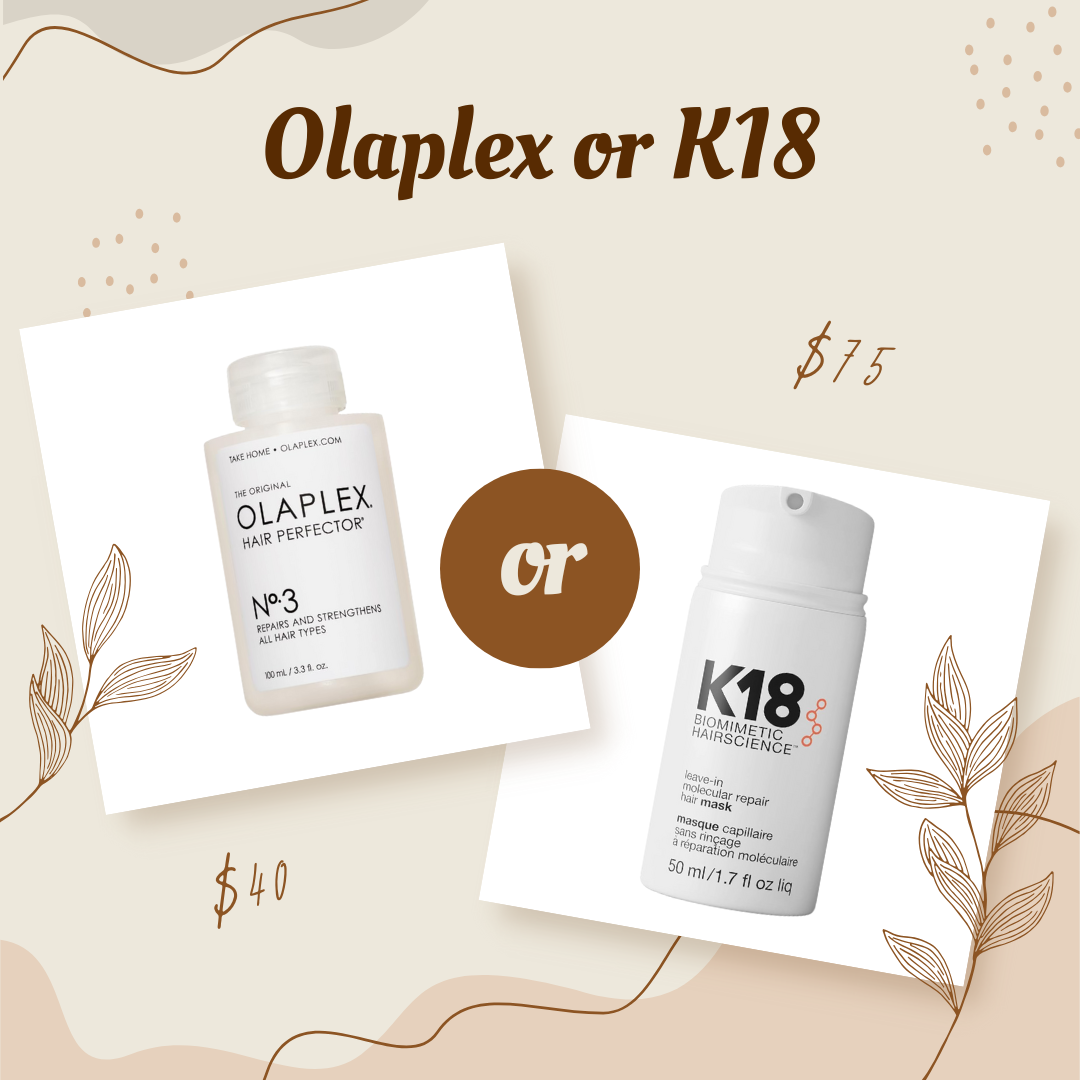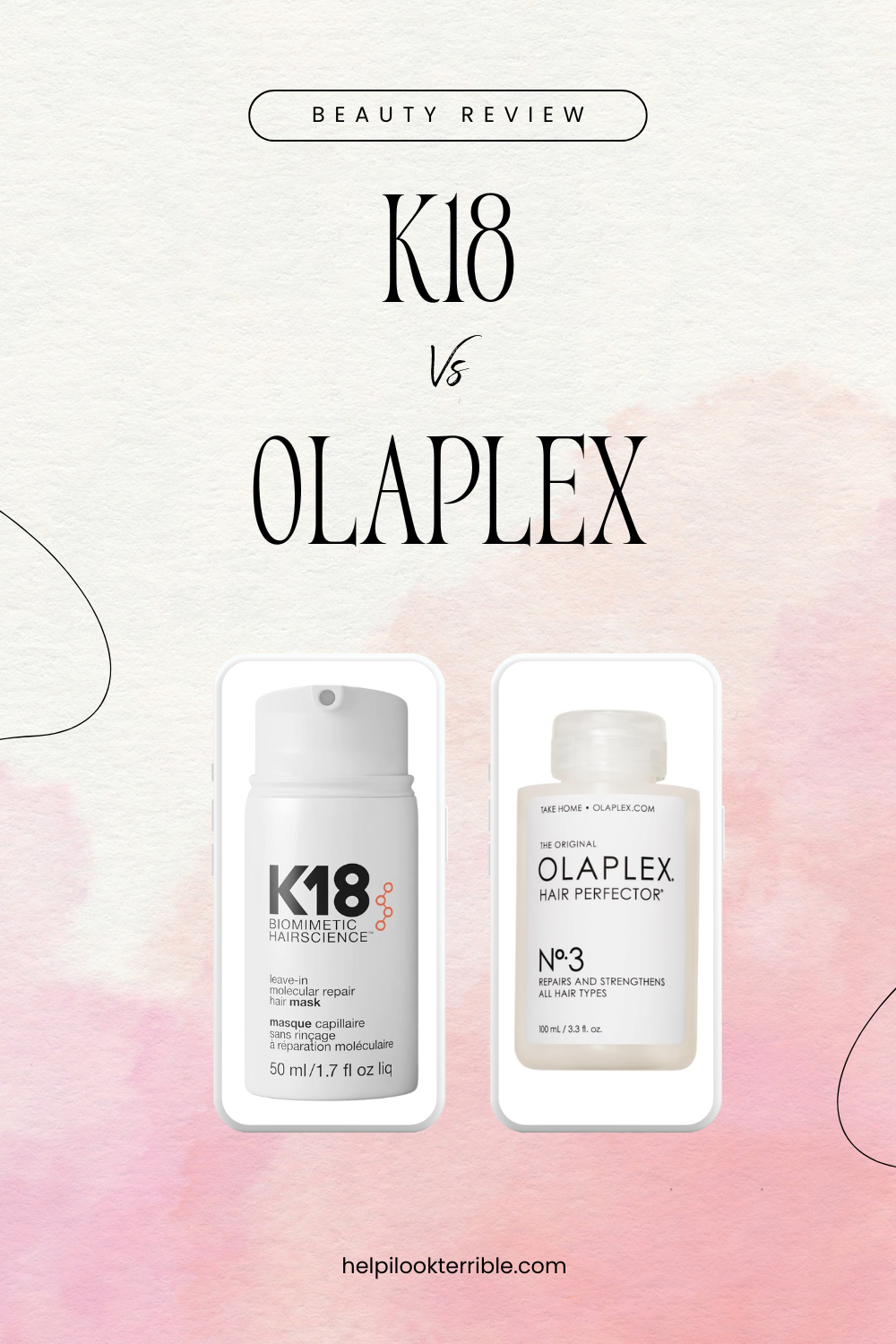K18 vs Olaplex Review: Which bond builder is better?
K18 and Olaplex are powerful hair bond builders widely touted as the most effective on the market. Both promise to repair damaged hair, but they work with different active and in very different ways. So which one is better value? Here’s a detailed comparrison.
K18 and Olaplex are powerful hair bond builders widely touted as the most effective on the market. Both promise to repair damaged hair, but they work with different active and in very different ways. So which one is better value?
I’ve put both to the test, you can read the Olaplex review here and the K18 review here, but this is more of a side-by-side analysis so you can work out which one might be better for you.
What do bond builders actually do?
Olaplex No. 3 Hair Perfector is part of the larger Olaplex hair treatment range and works to temporarily repair disulphide bonds in the hair. These are the bonds that break when you bleach, dye, or heat-style your hair to death. Olaplex’s ingredient, Bis-Aminopropyl Diglycol Dimaleate, works on a molecular level to restore strength and structure.
K18 Leave-In Molecular Repair Hair Mask claims to go deeper than surface-level fixes. It uses a bioactive peptide, the K18Peptide, designed to reconnect broken keratin chains—essentially repairing hair from the inside out. It's marketed as a lasting, progressive treatment that apparently reverses damage in just four minutes.
Does K18 fix split ends?
The only thing that repairs split ends is scissors. Repairing a split end is a bit like tearing a blade of grass through the middle and trying to put it back together. It won’t work. However, you can nourish your hair properly to prevent split ends. This is where bond builders come in.
K18 helps strengthen and smooth hair, which can reduce the appearance of split ends—but it won’t glue them back together. For true split-end removal, a trim is still your best bet. That said, K18 can help prevent future splitting by making the hair stronger and less prone to breakage.
Does Olaplex fix split ends?
Similar story. Olaplex No. 3 Hair Perfector doesn’t fix split ends, but it helps improve the overall integrity of the hair. The bond-building action may reduce how often split ends occur, especially with regular use.
Does K18 help hair grow?
K18 doesn’t stimulate hair growth directly. What it does do is strengthen hair so it breaks less, meaning you keep more of the length you already have. If your ends tend to snap off, K18 might help you hold on to inches longer.
Does Olaplex help hair grow?
Same deal. Olaplex hair treatment isn’t a growth serum, but it can support length retention by reducing damage and breakage. Healthier hair equals less trimming and more visible growth over time.
Is K18 a protein treatment?
Not in the traditional sense. While K18 works similarly to protein treatments by reinforcing the hair structure, it doesn’t contain actual protein. Instead, it uses a patented peptide to mimic and repair keratin chains from within. It’s designed to avoid the stiffness that can come from traditional protein overload.
Is Olaplex a protein treatment?
Nope. Olaplex 3 Hair Perfector is not a protein treatment either. It works on broken disulphide bonds—different from keratin or protein bonds—so you can use it even if your hair is sensitive to protein-heavy formulas.
How to use K18 and Olaplex
Olaplex No. 3 Hair Perfector: Apply to damp, towel-dried hair before shampooing and conditioning. Leave it on for 10 minutes or longer, rinse, then follow with your regular wash routine. It’s CG-friendly and safe for all hair types.
K18: Shampoo, do not condition, towel-dry until damp, then apply 1–3 pumps of the mask from roots to ends. Wait four minutes, then style as usual. Do not not rinse. In all honesty, this was problematic for me.
Which one lasts longer?
Olaplex isn’t permanent, but the effects stick around longer than one wash. With consistent use, it builds on itself and really helps improve the health of your hair over time.
K18 markets itself as a long-term fix that fixes your hair from the inside out, particularly with regular use.
Price breakdown
Olaplex No. 3 (100ml): Around $30–$40.
K18 Leave-In Mask (50ml): Roughly $75, with a 5ml trial size around $16.
When I tested them both out, I needed to use more Olaplex to properly detangle my hair and get a brush through it, but not a huge amount. With the comparatively lower cost, that’s justified.
You’re not supposed to use a huge amount of K18, but I found it incredibly difficult to use on hair that was not conditioned. To try and get a brush through it, I needed to use more product. For the price, I didn’t think the amount I had to use was justified.
K18 v Olaplex: A Comparison
| Feature | Olaplex No. 3 | K18 Leave-In Mask |
|---|---|---|
| Best for | Bleached, dyed, heat-damaged hair | Bleached, chemically treated, or heat damaged hair |
| Application | Rinse-out treatment | Leave-in treatment |
| Slippage | High slip, detangles easily | No slippage |
| Key Ingredient | Bis-Aminopropyl Diglycol Dimaleate | K18Peptide (bioactive peptide) |
| How long does it take to work? | 3-10 minutes, rinse out | 4 minutes, leave in |
| Where is it made? | USA | USA |
| Split ends? | Helps prevent, doesn't fix | Helps prevent, doesn't fix |
| Hair growth? | Helps retain length | Helps retain length |
| Protein treatment? | No | Not technically, but similar effect |
| Price | $30–$40 | $75-$120 |
| Bottle Size | 100ml | 50ml-100ml |
My experience
Olaplex No. 3: This one made my hair feel smoother, shinier, and way easier to detangle after the first try. It didn’t magically heal my hair overnight, but after a few weeks of using it every other wash, I noticed less breakage and frizz. My hair held moisture longer and didn’t feel like straw by day four. There was also significantly less hair in the brush.
K18: This did not start off well. The first time I tried it, I followed the instructions exactly—no conditioner, damp hair, four-minute wait. My curls were flat, dry, and felt like hay. Detangling was awful. Three days later, I had to wash again because my hair was so matted.
I gave it another go a few months later—this time after conditioner, applied to soaking wet hair. And honestly, that worked better. My hair felt good that day. But the more I used K18, the more I noticed my hair getting dry and brittle again. You can read more about that in my K18 review.
Verdict
If I had to pick between K18 and Olaplex, Olaplex easily wins. It’s more affordable, the bottle is larger, it detangles your hair, and works with your regular hair care routine. It actually made my hair feel healthier. K18 might work wonders for some, especially those with extreme chemical damage, but for me it wasn’t worth the hassle or the price.
But everyone’s hair is different. Some people swear by K18. If you’re curious, I’d say start with the sample size.
Have you tried a different bond builder? Let me know in the comments below!
Like it? Pin it!
You Might Also Like…
K18 hair mask review: Does it actually work?
K18 leave-in molecular repair mask has been touted as the holy grail of bond builders, repairing your hair from the inside out. But does it work? Here’s my honest review.
K18 leave-in molecular repair mask has been touted as the holy grail of bond builders, repairing your hair from the inside out. But does it work?
Unlike many other bond builders on the market that apparently repair the outside of each strand, the K18 leave-in mask is supposed to be best for internal hair care. Basically, it’s meant to reach right through to the keratin bonds and heal them, giving you healthier and more resilient hair.
I was after a bond repair product because I have curly hair tangles very easily and I wanted to know if the issue stemmed from inside the hair strand. I read a lot of positive reviews, mostly from people with bleached hair and visible damage. I was spending about half an hour detangling my hair with conditioner every wash day and I was pretty desperate to fix that problem (here’s how I actually fixed the problem).
According to the K18 hair product website, your hair will be ‘like new’. It’s also meant to be for all hair types and works its magic in just four minutes.
I was sceptical, but I love a popular product and a bold claim so I decided to give it a crack. Here’s what happened.
K18 hair mask review
The first thing I noticed about K18 bond repair mask was how expensive it was, particularly when I didn’t know if it would work or not. I bought a 5ml sample size tube which still costs about AU$16, but I figured it was better than buying a full-price 50ml bottle for $120. Since I only had a small amount, I didn’t have much to experiment with so I followed the instructions carefully.
According to the instructions, you’re supposed to wash your hair with shampoo but don’t condition it. Towel dry hair until it’s damp and rake one pump of the K18 treatment through your hair, adding more as needed, working from the roots to the ends. Let it sit for four minutes, style hair as normal.
For someone with curly hair that tangles easily and relies on conditioner alone to detangle, the prospect of not conditioning my hair after shampooing was frightening. Nevertheless, I gritted my teeth and got on with it.
What happened
As expected, my hair was nice and tangled after using shampoo. I briefly tried to detangle with my fingers but gave up quickly, hoping K18 would solve those problems. My anxiety levels increased again as I towel-dried unconditioned and matted hair.
My hair was damp by the time I picked up the tube of K18. There was no drip at all. I squeezed a bit onto my hand and started trying to rake it through. The product is white, thick and feels a lot like a conditioning mask to touch.
Sadly, it did not behave like a conditioner.
I immediately started applying it to the ends of my hair, where the largest knots were, slowly trying to detangle with my fingers while trying to imagine the shiny, lush locks I’d have once this painful process was over. I ended up using a tangle teaser to get them out properly, before working the rest of the product up the strand.
I’m not going to lie, it was tough.
The product has very little slip, which essentially means it won’t properly detangle hair. This process took quite a long time. I did eventually manage to get a brush through it, making sure each strand was coated. My damp hair felt brittle with the product in it, but I hoped that would fade away as it dried.
By the time I was done, I’d used most of the 5ml tube. I didn’t use any other product and left it to air dry.
The result
I would actually call this a disaster.
My hair felt like hay. It was crisp, brittle and flat. There was no curl definition at all—there was barely a wave. My hair hated the lack of conditioner and it really hated being detangled with virtually no assistance from a product with high slippage.
Sometimes, when my hair becomes brittle after using a high-protein treatment, it softens throughout the day. I wondered if that would happen with K18. It did not. Nor did it soften the next day. By day three, it was matted and looked terrible and I had to wash it again. I used conditioner this time, without K18, and everything went back to normal.
Usually, my hair becomes brittle when I use a product with too much protein. I did some research and found K18 is not a protein treatment. It has no protein at all, so that can’t have been the problem.
I noticed no improvement in my hair after using K18.
The second attempt
After the disaster, I left the tube of K18 in the bathroom and didn’t look at it again for months. It wasn’t until I went to the hairdresser that I decided to give it another go.
The hairdresser used K18 on my hair, but he applied it after conditioner and on very wet hair. I asked why he did that because the packet explicitly says to use K18 on unconditioned hair. He confirmed you are technically only supposed to use it on unconditioned hair, but he also said it doesn’t really matter—the product works whether you condition it or not, but it might be a bit less effective if you’ve conditioned and rinsed your hair. When he was done cutting my hair, it did feel amazing. There was no dryness at all, like there was after my own attempt with K18.
I was floored and decided to give it another go.
I washed my hair, conditioned and detangled, as normal. This time, I didn’t towel dry my hair. I applied K18 pretty soon after getting out of the shower. It was easy to apply this time and I brushed it from root to end with ease. I let it drip dry. My hair felt great. I decided to give it a proper go with a full-size bottle.
Over the following months, I used K18 every five to six washes, as stated on the packet. At the start, it was hard to tell if my hair only felt good because of the conditioner, rather than because the K18 was repairing my hair. After a few months of use, I was convinced that was the case. The last few times I used it after rinsing out the conditioner, my hair started feeling brittle again.
It continued to feel brittle until I stopped using K18.
The verdict
I still use K18 about once every six months, largely to use up the rest of the bottle. If I use it more frequently than that, my hair feels brittle all over again.
According to the K18 website, brittle hair after use can mean there’s product buildup on the hair which stops the K18 from penetrating the strand. To fix that problem, they recommend using the K18 clarifying shampoo…because of course they do. I used a sulphate-heavy shampoo to remove buildup and it made no difference.
I know this product works for a lot of people, and I was pretty sad that it didn’t work for me. Of course, that doesn’t mean it won’t work for you. As I mentioned, people with bleached and dye-damaged hair have reported huge success with K18. The product clearly works, but like a lot of things, it’s highly dependent on the individual.
Want me to review something else? Let me know in the comments below!
Like it? Pin it!
You Might Also Like…
AFFILIATES
I use affiliate links and advertising on this site, which just means that if you buy a product through a link on this site, I'll get a small commission (not all links are affiliate links). This is because all the content I provide here is free, and I want to keep it that way :)















